Abstract
The degree of the inoculum effect shown by the new beta-lactam antibiotics with Pseudomonas aeruginosa was investigated, and the antibiotics were divided into three groups based upon the observations. The group 1 antibiotics (cefotaxime, moxalactam, cefoperazone, azlocillin, piperacillin, and aztreonam) demonstrated a large inoculum effect, were poorly bactericidal, produced aberrant, elongated bacilli, and did not inhibit the increase in turbidity of high inocula during an 18-h incubation. The group 2 antibiotics (ceftazidime and ticarcillin) were slowly bactericidal, caused minimal formation of aberrant, elongated bacilli, and slowly decreased the turbidity of high inocula. The group 3 antibiotics (imipenem and gentamicin) were bactericidal, did not cause the formation of elongated bacilli, and decreased the turbidity of high inocula rapidly. Data are presented which suggest that the inoculum effect seen with the group 1 beta-lactam antibiotics is related to (i) the poor intrinsic antibactericidal activity of these antibiotics for P. aeruginosa at the inocula tested and (ii) failure of these antibiotics to inhibit the formation of aberrant and filamentous bacilli, which can result in increased bacterial mass and turbidity.
Full text
PDF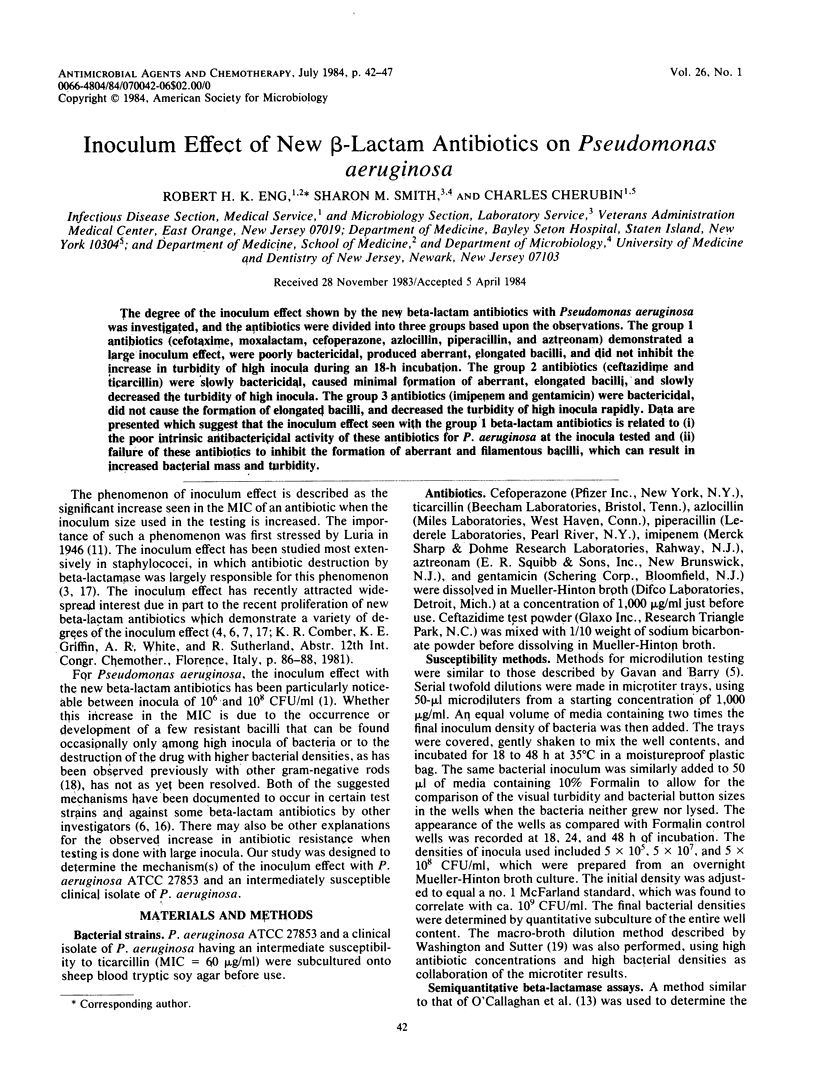
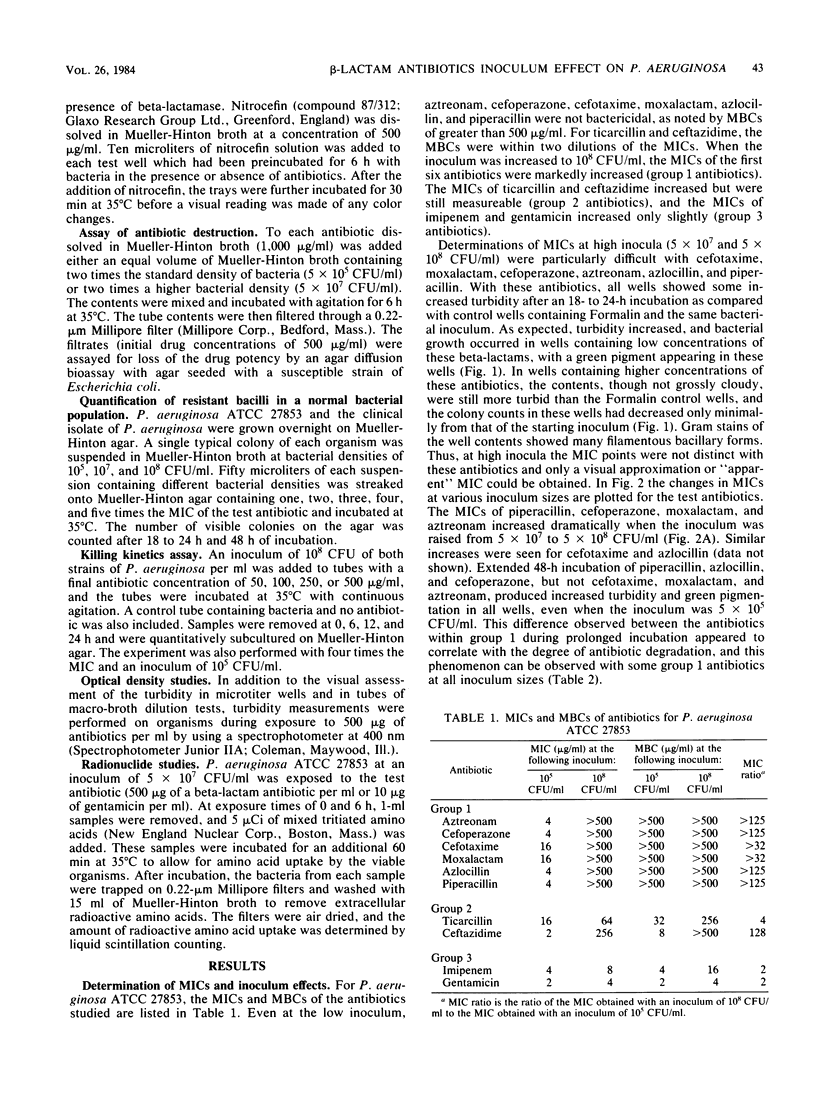
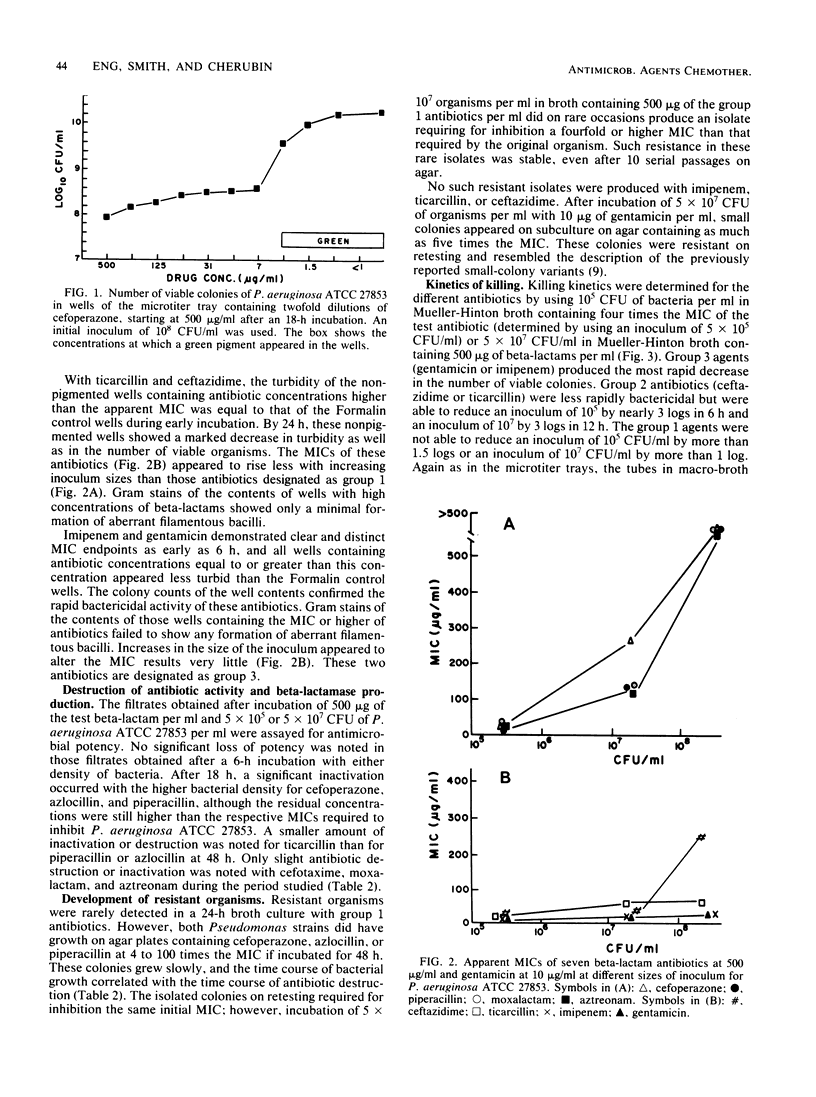
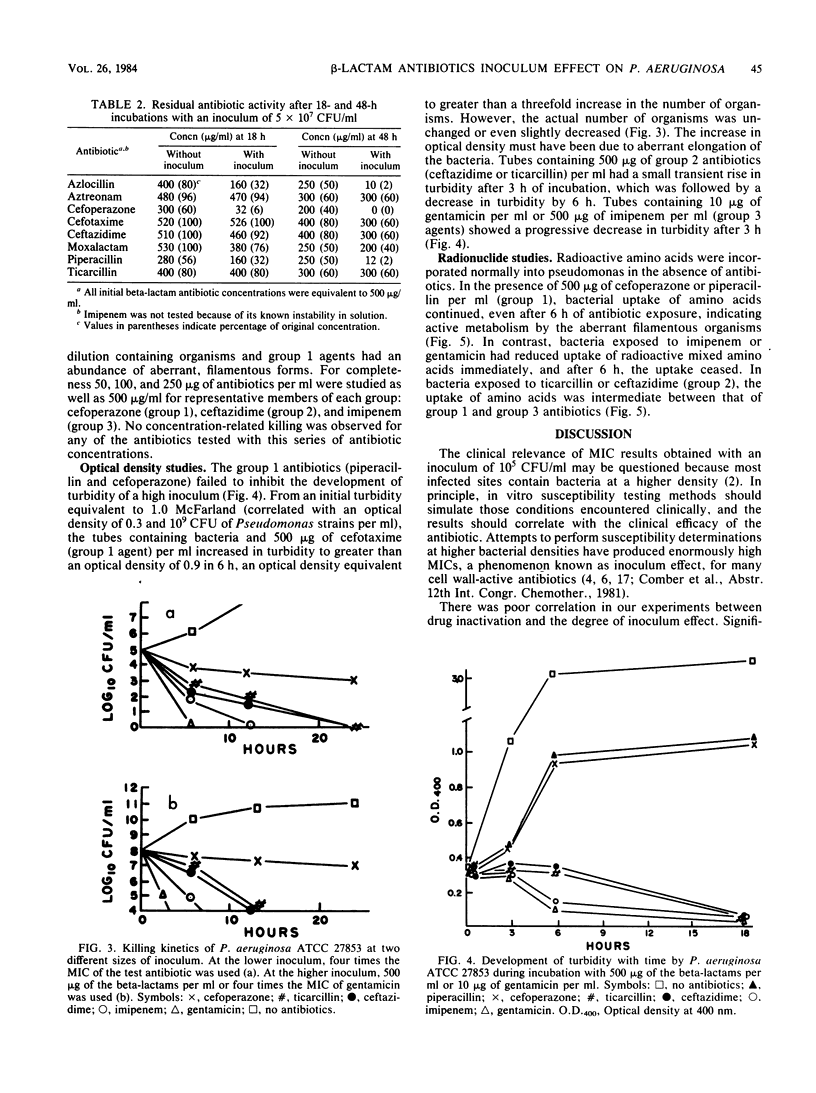
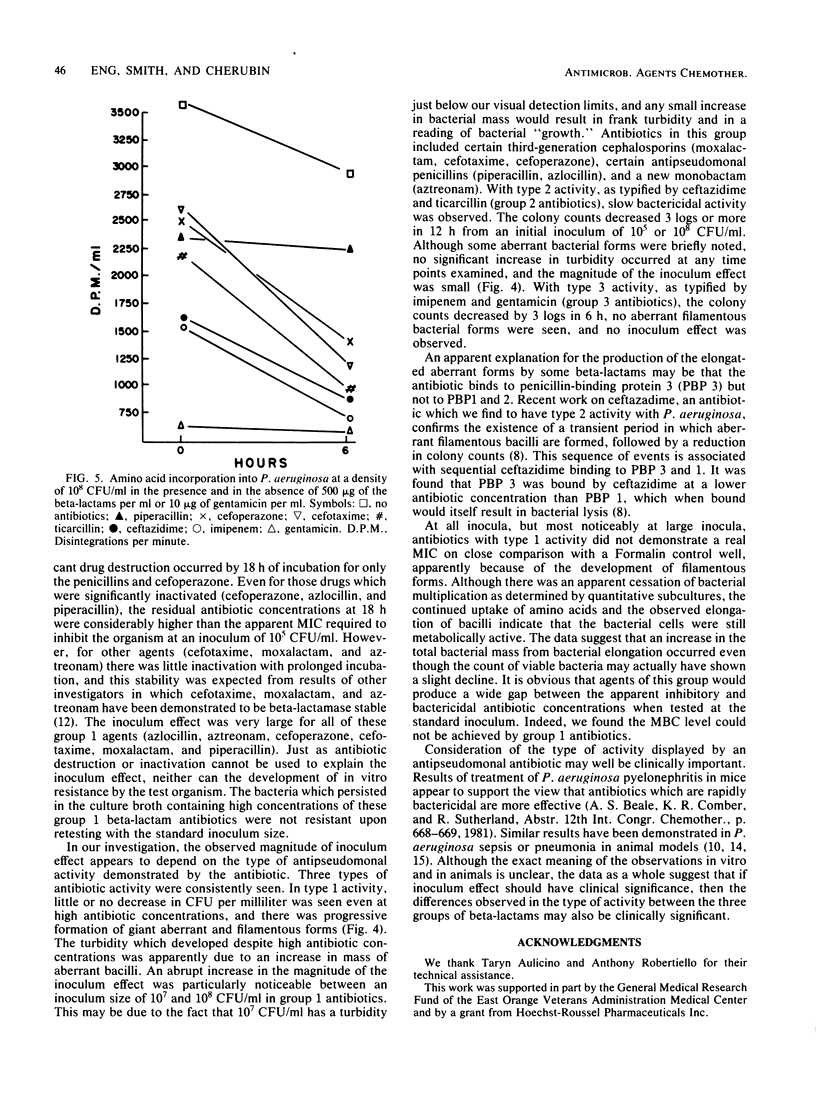
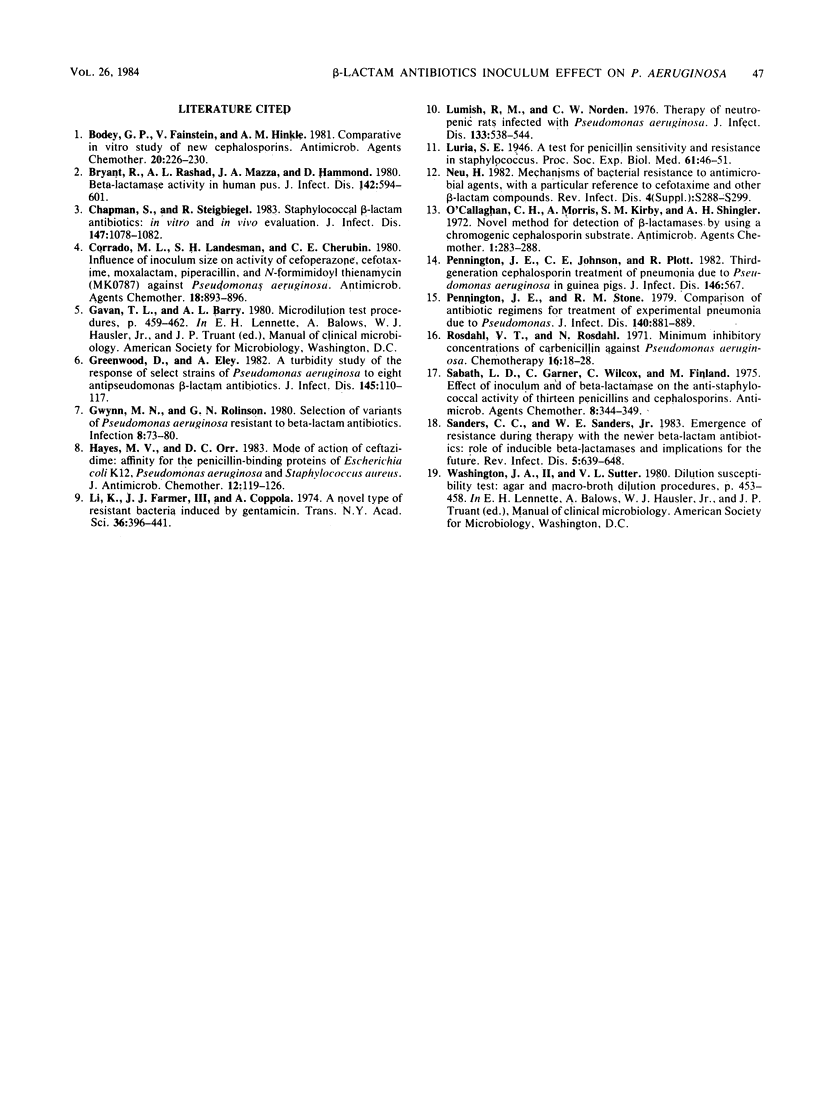
Selected References
These references are in PubMed. This may not be the complete list of references from this article.
- Bodey G. P., Fainstein V., Hinkle A. M. Comparative in vitro study in new cephalosporins. Antimicrob Agents Chemother. 1981 Aug;20(2):226–230. doi: 10.1128/aac.20.2.226. [DOI] [PMC free article] [PubMed] [Google Scholar]
- Bryant R. E., Rashad A. L., Mazza J. A., Hammond D. beta-Lactamase activity in human pus. J Infect Dis. 1980 Oct;142(4):594–601. doi: 10.1093/infdis/142.4.594. [DOI] [PubMed] [Google Scholar]
- Chapman S. W., Steigbigel R. T. Staphylococcal beta-lactamase and efficacy of beta-lactam antibiotics: in vitro and in vivo evaluation. J Infect Dis. 1983 Jun;147(6):1078–1089. doi: 10.1093/infdis/147.6.1078. [DOI] [PubMed] [Google Scholar]
- Corrado M. L., Landesman S. H., Cherubin C. E. Influence of inoculum size on activity of cefoperazone, cefotaxime, moxalactam, piperacillin, and N-formimidoyl thienamycin (MK0787) against Pseudomonas aeruginosa. Antimicrob Agents Chemother. 1980 Dec;18(6):893–896. doi: 10.1128/aac.18.6.893. [DOI] [PMC free article] [PubMed] [Google Scholar]
- Greenwood D., Eley A. A turbidimetric study of the responses of selected strains of Pseudomonas aeruginosa to eight antipseudomonal beta-lactam antibiotics. J Infect Dis. 1982 Jan;145(1):110–117. doi: 10.1093/infdis/145.1.110. [DOI] [PubMed] [Google Scholar]
- Gwynn M. N., Rolinson G. N. Selection of variants of Pseudomonas aeruginosa resistant of Beta-lactam antibiotics. Infection. 1980;8(2):73–80. doi: 10.1007/BF01639151. [DOI] [PubMed] [Google Scholar]
- Hayes M. V., Orr D. C. Mode of action of ceftazidime: affinity for the penicillin-binding proteins of Escherichia coli K12, Pseudomonas aeruginosa and Staphylococcus aureus. J Antimicrob Chemother. 1983 Aug;12(2):119–126. doi: 10.1093/jac/12.2.119. [DOI] [PubMed] [Google Scholar]
- Li K., Farmer J. J., 3rd, Coppola A. A novel type of resistant bacteria induced by gentamicin. Trans N Y Acad Sci. 1974 May;36(5):396–415. doi: 10.1111/j.2164-0947.1974.tb01592.x. [DOI] [PubMed] [Google Scholar]
- Lumish R. M., Norden C. W. Therapy of neutropenic rats infected with Pseudomonas aeruginosa. J Infect Dis. 1976 May;133(5):538–547. doi: 10.1093/infdis/133.5.538. [DOI] [PubMed] [Google Scholar]
- Neu H. C. Mechanisms of bacterial resistance to antimicrobial agents, with particular reference to cefotaxime and other beta-lactam compounds. Rev Infect Dis. 1982 Sep-Oct;4 (Suppl):S288–S299. doi: 10.1093/clinids/4.supplement_2.s288. [DOI] [PubMed] [Google Scholar]
- O'Callaghan C. H., Morris A., Kirby S. M., Shingler A. H. Novel method for detection of beta-lactamases by using a chromogenic cephalosporin substrate. Antimicrob Agents Chemother. 1972 Apr;1(4):283–288. doi: 10.1128/aac.1.4.283. [DOI] [PMC free article] [PubMed] [Google Scholar]
- Pennington J. E., Johnson C. E., Platt R. Third-generation cephalosporins in the treatment of pneumonia due to Pseudomonas aeruginosa in guinea pigs. J Infect Dis. 1982 Oct;146(4):567–567. doi: 10.1093/infdis/146.4.567. [DOI] [PubMed] [Google Scholar]
- Pennington J. E., Stone R. M. Comparison of antibiotic regimens for treatment of experimental pneumonia due to Pseudomonas. J Infect Dis. 1979 Dec;140(6):881–889. doi: 10.1093/infdis/140.6.881. [DOI] [PubMed] [Google Scholar]
- Rosdahl V. T., Rosdahl N. Minimum inhibitory concentrations of carbenicillin against Pseudomonas aeruginosa. Investigations on the inoculum effect. Chemotherapy. 1971;16(1):18–28. doi: 10.1159/000220711. [DOI] [PubMed] [Google Scholar]
- Sabath L. D., Garner C., Wilcox C., Finland M. Effect of inoculum and of beta-lactamase on the anti-staphylococcal activity of thirteen penicillins and cephalosporins. Antimicrob Agents Chemother. 1975 Sep;8(3):344–349. doi: 10.1128/aac.8.3.344. [DOI] [PMC free article] [PubMed] [Google Scholar]
- Sanders C. C., Sanders W. E., Jr Emergence of resistance during therapy with the newer beta-lactam antibiotics: role of inducible beta-lactamases and implications for the future. Rev Infect Dis. 1983 Jul-Aug;5(4):639–648. doi: 10.1093/clinids/5.4.639. [DOI] [PubMed] [Google Scholar]


